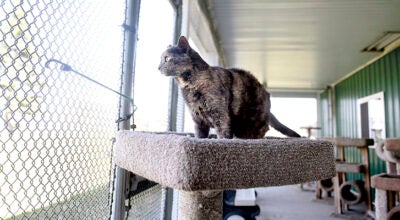Flex factor
Published 3:05 pm Saturday, March 20, 2010
Dan Erickson wouldn’t have it any other way. Every time the Alden farmer puts gas in his wife’s 2007 GMC Yukon, he makes sure he does so with E-85 fuel.
His reasons?
“For one, it’s produced locally,” he says. “Two, it’s cleaner for the environment and three, it’s cheaper. Since I’ve owned (the Yukon), I’ve never put in anything but.”
Erickson is a corn farmer who sells his crop at the Poet co-op in Glenville. As one of hundreds of members/owners of the co-op, Erickson delivers his corn to the facility, which in turn makes it into Ethanol, which is then either blended on site with gasoline to make E-85 or sold to other wholesalers who blend it themselves.
The fuel, which basically blends 85 percent Ethanol and 15 percent gasoline, has skyrocketed in popularity over the past decade in the United States and especially here in Minnesota.
“Minnesota leads the country with 355 E-85 stations,” says Kelly Marczak, director of clean fuel and vehicle technologies for the American Lung Association of Minnesota.
In the U.S., there are roughly 2,200 E-85 retailers, and Minnesota has been a leader in the development and use of the fuel for more than a decade.
In 1998, the Twin Cities was selected by the U.S. Department of Energy as one of the three pilot markets for E-85 to build the fueling infrastructure and customer market. A coalition of partners called the Minnesota E-85 Team came together to accomplish this goal.
And accomplish it they did.
When the project began, there were only seven E-85 stations in the state.
Flash forward to 2010, where there are now more than 50 times that.
“The American Lung Association in Minnesota recognizes E-85 as a Clean Air Choice motorists can make today to reduce their impact on the environment and lung health,” Marczak says. “…E-85 and intermediate ethanol blends provide a home grown, renewable choice that provides local jobs and supports Minnesota families.”
How it works
E-85 is 85 percent Ethanol and 15 percent gasoline.
According to the American Lung Association, Ethanol is an ethyl alcohol used as a transportation fuel and historically produced by fermentation of sugars. In the United States, ethanol is primarily produced from the starch component of corn and other grain products. In other countries, Ethanol is made from other starches, such as sugar cane in Brazil.
Since the late 1990s, automobile manufacturers have increased their fleets of vehicles that are flex fuel (such as E-85) compatible. Such vehicles can run on E-85 or regular gasoline. Any vehicle built before the mid 1990s or any that is not specifically designated as a flex-fuel compatible vehicle, cannot run on E-85.
In addition, E-85 prices tend to be 20 percent less on average than unleaded gasoline, but experts and users say gas mileage also decreases about 20 percent with E-85, evening things out.
As a result of state and federal requirements, Minnesota’s Department of Administration has increased its use of flex-fuel compatible vehicles dramatically over the past five years.
As of 2010, the state has 2,500 of the vehicles in its fleet and used more than 800,000 gallons of E-85 in 2009 alone.
“Those are gallons of gasoline we did not use,” said Tim Morse, director of fleet and surplus services within the Department of Administration.
State vehicles using E-85 include the state patrol’s Crown Victorias.
E-85 and Austin
There are two gas stations in the Austin city limits that carry E-85, Budget Oil, 501 E. Oakland Ave. and Kwik Trip, 1401 Fourth St. NW.
In addition, there is a large selection of flex fuel-compatible vehicles for sale in Austin.
Tom Sherman, owner of Usem’s Inc., says roughly 80 percent of the General Motors vehicles he stocks at his dealership are E-85 compatible, and he specifically orders them that way.
“I do that because we live in the corn belt; corn is our economy,” he says. “It’s good for the environment, it’s good for the consumer, it’s good all the way around. Why wouldn’t you buy an E-85 vehicle when it helps the economy and doesn’t cost any more?”
Sherman adds that GMC is the leader in E-85 engine technology.
Other automotive makers that produce E-85-compatible vehicles include Ford, Mercedes, Nissan and Toyota.
By the numbers
A complete list of E-85 compatible vehicles and a list of E-85 stations nationwide is available at www.cleanairchoice.org.
According to the American Lung Association, an estimated 175,000 flexible fuel vehicles are registered in Minnesota, using 20-25 million gallons of E-85 each year.
Those numbers matter to people like Dan Erickson, the Alden farmer who also produces soybeans and alfalfa.
“It’s not just the farmer that’s getting the added values (of E-85),” Erickson says. “It’s the people working at the plants and the ones who drive the trucks. It’s good for the rural community.”




